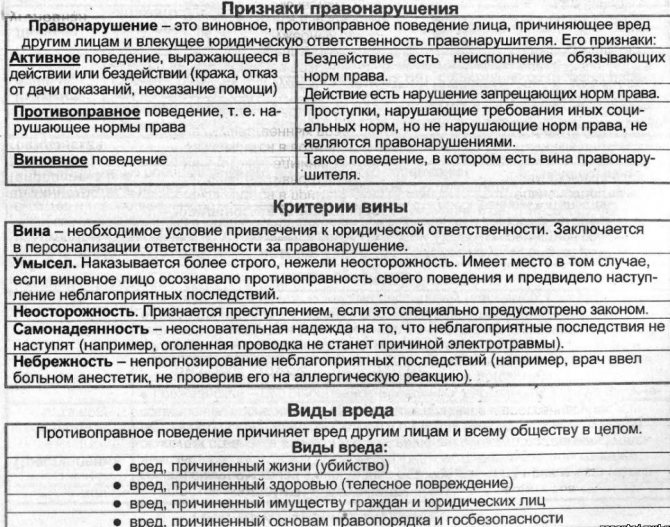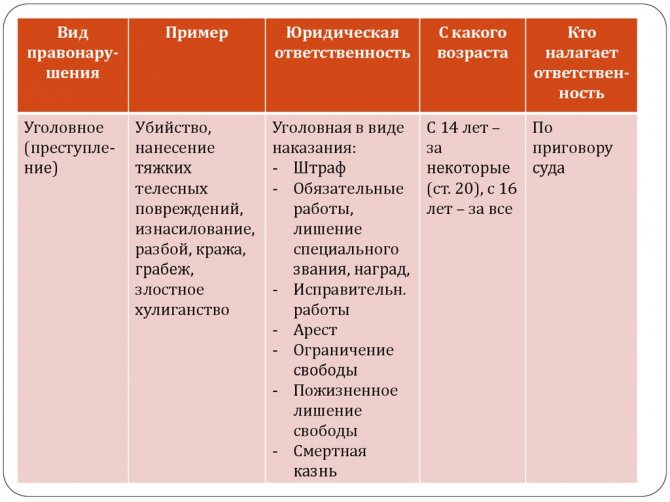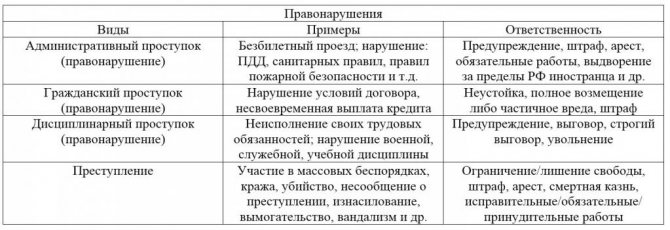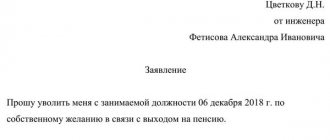Home / Labor Law / Responsibility / Disciplinary
Back
Published: 05/21/2016
Reading time: 7 min
0
2369
The legislation of the Russian Federation provides for clearly established rules and norms of behavior, violating which a citizen commits an offense or a crime, depending on whether this action belongs to a particular area of offenses.
Misdemeanors, in turn, are of several types: civil, administrative, disciplinary.
The main feature of a disciplinary offense is that it is closely related to labor relations.
- What is disciplinary action?
- What constitutes disciplinary offences?
- What is not considered a disciplinary offense?
- Penalties
Concept
Channel PROGRAMMER'S DIARY
The life of a programmer and interesting reviews of everything. Subscribe so you don't miss new videos.
An offense is an antisocial act (inaction) that causes harm to citizens and society, for which there is a certain liability established by current legislation.
You may be interested in: The Inca Empire: the flag as a symbol of a disappeared state
In addition to causing private harm, illegal acts cause irreparable harm to society itself and disorganize the development of relations in society. It is no secret that in any country (as the economic and political situation worsens) the number of socially dangerous acts increases. And this has a negative impact on the emergence of positive changes in society and the state itself.

Characteristics of the form of offense under consideration
We have considered what offenses are, but all of them can affect different areas of our lives and are committed in relation to, for example, administrative or civil norms. It is on this basis that the classification is built.
Russian artist Vladimir Borisovich loved only one woman all his life. He met his wife Alla Konstantinova at the university when she was in her third year. Korenev initially did not make any impression on her, since Alla did not pay attention to male appearance.
Thus, we can say that in the public mind these words differ only in the seriousness of the violation. Criminologists have their own opinion on this matter.
This definition meets the rule of proportionality. Those. the volume of the determined - A, is equal to the volume of the determining - Bc.
Signs
Today, it is customary to distinguish between 4 signs of offenses that are interconnected, and if at least one of them is absent, then we will no longer be talking about an antisocial act.
- Socially dangerous character. In simple terms, a certain action or inaction causes harm. At first glance, even an antisocial act may not be noticeable, but the consequences of the act may become obvious after some time. In this case, actions can cause material or non-material damage.
- Illegality. An offense is necessarily an action (inaction) that leads to a violation of current legislation, for which sanctions or punishment are provided.
- Guilty act. This means that the person committing the act must be aware of what he is doing, he must be held accountable for the offense, regardless of whether he knows the law or not.
- Harm. Not every act or omission is an offence. An antisocial act that caused harm, but committed out of extreme necessity or within the framework of self-defense, will not be considered.

Interesting fact. In some countries (in ancient times), animals were also considered subjects of law, that is, it was believed that they could commit crimes.

Excerpt characterizing the Misdemeanor
“And I know that she will see; she saw last year too. For about three minutes everyone was silent. “Certainly!” Natasha whispered and didn’t finish... Suddenly Sonya moved away the mirror she was holding and covered her eyes with her hand. - Oh, Natasha! - she said. – Did you see it? Did you see it? What did you see? – Natasha screamed, holding up the mirror. Sonya didn’t see anything, she just wanted to blink her eyes and get up when she heard Natasha’s voice saying “definitely”... She didn’t want to deceive either Dunyasha or Natasha, and it was hard to sit. She herself did not know how or why a cry escaped her when she covered her eyes with her hand. – Did you see him? – Natasha asked, grabbing her hand. - Yes. Wait... I... saw him,” Sonya said involuntarily, not yet knowing who Natasha meant by the word “him”: him - Nikolai or him - Andrey. “But why shouldn’t I say what I saw? After all, others see! And who can convict me of what I saw or did not see? flashed through Sonya's head. “Yes, I saw him,” she said. - How? How? Is it standing or lying down? - No, I saw... Then there was nothing, suddenly I see that he is lying. – Andrey is lying down? He is sick? – Natasha asked, looking at her friend with fearful, stopped eyes. - No, on the contrary, - on the contrary, a cheerful face, and he turned to me - and at that moment as she spoke, it seemed to her that she saw what she was saying. - Well, then, Sonya?... - I didn’t notice something blue and red... - Sonya! when will he return? When I see him! My God, how I’m afraid for him and for myself, and for everything I’m afraid...” Natasha spoke, and without answering a word to Sonya’s consolations, she went to bed and long after the candle had been put out, with her eyes open, she lay motionless on the bed and looked at the frosty moonlight through the frozen windows. Soon after Christmas, Nikolai announced to his mother his love for Sonya and his firm decision to marry her. The Countess, who had long noticed what was happening between Sonya and Nikolai and was expecting this explanation, silently listened to his words and told her son that he could marry whomever he wanted; but that neither she nor his father would give him his blessing for such a marriage. For the first time, Nikolai felt that his mother was unhappy with him, that despite all her love for him, she would not give in to him. She, coldly and without looking at her son, sent for her husband; and when he arrived, the countess wanted to briefly and coldly tell him what was the matter in the presence of Nicholas, but she could not resist: she cried tears of frustration and left the room. The old count began to hesitantly admonish Nicholas and ask him to abandon his intention. Nikolai replied that he could not change his word, and the father, sighing and obviously embarrassed, very soon interrupted his speech and went to the countess. In all his clashes with his son, the count was never left with the consciousness of his guilt towards him for the breakdown of affairs, and therefore he could not be angry with his son for refusing to marry a rich bride and for choosing the dowryless Sonya - only in this case did he more vividly remember what, if things weren’t upset, it would be impossible to wish for a better wife for Nikolai than Sonya; and that only he and his Mitenka and his irresistible habits are to blame for the disorder of affairs.
Crime
One of the types of offenses (table below) is a crime. This concept is enshrined only in criminal law; in other industries such a term does not exist. Different types of crimes carry different penalties. Some crimes involve liability in the form of a fine, others in the form of deprivation of liability, and so on.
Even minors aged 14 years or older can be convicted for some crimes, and for a number of others only from 16 years old. The main thing that unites them is that responsibility for a crime can only occur after a court decision.

What is not considered a disciplinary offense?
An employer does not have the right to impose disciplinary liability on an employee if:
- the employee, without giving any reason, refused to go to work until the end of his vacation;
- the specialist refused to perform work that did not meet labor protection requirements and could pose a health hazard;
- the employee did not agree to perform hard work not provided for in the employment contract;
- the employee did not fulfill his duties for reasons beyond his control;
- the employee failed to fulfill a public order;
- the employee refused further work due to non-payment of wages;
- the employee refused to comply with the employer’s illegal demands.
Compensation for work in hazardous working conditions - find out what you can count on! What allowances are available to state employees and under what conditions? The link contains information about what length of service gives you.
Find out more about the most effective remuneration system - the bonus system. Our article has all the information about it.
Disciplinary
This type of offense (table attached) is most often found in the sphere of labor, military and educational relations. Responsibility measures can be enshrined not only in legislative acts, but also in local and departmental ones. For example, offenses in the military sphere are defined in regulations. The Labor Code provides for liability for violations in the relationship between employer and employee.
Disciplinary responsibility can be expressed in the form of a warning, reprimand, fine or dismissal. Sanctions against the violator can be imposed no later than 6 months from the date of commission of the act.

What constitutes disciplinary offences?
Punishment can be applied to an employee if:

- the absence of a specialist from the workplace was recorded;
- the employee expressed disagreement with changes in labor standards, and therefore refused further work activities;
- the specialist refused to undergo a medical commission (for professions where this is mandatory);
- the employee did not want to undergo training or advanced training when further work activities are impossible without it;
- the employee expressed disagreement to sign a liability agreement in the case where his work is closely related to the maintenance of valuable items.
Gross violations of labor discipline include:
- absenteeism;
- being at work under the influence of drugs or alcohol;
- amoral behavior;
- presenting false documents to the employer;
- disclosure of secrets;
- recorded fact of theft;
- non-compliance with labor safety rules, resulting in serious consequences;
- repeated violations of labor discipline;
- an unreasonably made decision, as a result of which the company suffered significant damage;
Administrative
Such offenses are prescribed in the Administrative Code. They are characterized by the fact that the offender’s actions are associated with an encroachment on public or state property or committed against the established law and order in the country. Perhaps this is the most extensive category of antisocial acts, for which liability is provided not only by the administrative code of offenses, but also by land legislation, financial, procedural and other industry regulations.
However, law enforcement and other authorized bodies have the right to apply sanctions for administrative offenses no later than two months from the date of their commission (in some cases a longer period is provided - 1 year).
In everyday life, we most often encounter violations in the form of traffic violations, ticketless travel on public transport, and petty hooliganism. Businesses are most often held liable for violating tax laws and fire safety regulations.

Meaning

Any person, even not too old, can remember a certain number of misdeeds in his life. The boy ate his sister’s apple, did not share the candy with her, or, playing in the sandbox, sprinkled sand on his friend out of frustration. When a person grows up, he has other reasons to be dissatisfied with himself: we often cheat to win small privileges for ourselves.
We don’t need to explain what an offense is, because there are enough of them in the everyday life of every person. The dictionary contains the following meaning: “an act that violates the rules of conduct, a fault.” Thus, according to the smart book, the object of study is not considered something serious.
Whether this is so, we will find out further, because book reality and objective reality often differ from each other. But for now, let’s find out what can, on occasion, replace the noun that interests us.
Civil law
Such socially dangerous acts are associated with property and non-property relations. This refers to offenses aimed at causing harm to a person’s property and/or himself. The main provisions on civil offenses are enshrined in the Civil Code. It is this legislative act that is designed to protect the rights of the country's citizens.
Most often, liability for a violation is a requirement to restore the violated right, compensation for harm and damage caused.

Offense: concept and types. Misdemeanors and crimes.
A tort is a culpable unlawful act by a competent person that causes harm to society.
An offense is understood as such unlawful behavior of a person, which is expressed in action or inaction.
Thoughts, feelings, and intentions cannot be offenses, since they do not fall under the regulating influence of law until they are expressed in a specific behavioral act.
Inaction is an offense if a person was supposed to perform certain actions provided for by the law (provide assistance, take care of children, etc.), but did not perform them.
Signs of an offense
Signs of an offense:
§ action or inaction;
§ illegality of behavior (it does not matter the fact that the offender does not know the requirements of the law);
§ guilty behavior of a person;
§ causing harm to society, the state, citizens or creating a threat of such harm. It should be noted that not all causing harm is an offense (these are necessary defense, extreme necessity, etc.);
§ commission of an act by a legally capable person.
Thus, an offense is (1) an act, i.e. an action or inaction that violates legal norms, (2) which is committed by a legally competent person (3) through the fault of this person, i.e. by intent or negligence, which (4) is dangerous to society because it causes harm to others. An official negative sanction—punishment—is provided for an offense.
Guilty human behavior
Guilt is the mental attitude of the offender to the violated rule of law, the committed act. the resulting consequences.
Depending on how the offender relates to these components, two forms of guilt are distinguished:
§ intent;
§ negligence.
Intent is present when a person realizes the illegality of an act, foresees the occurrence of socially dangerous consequences and desires their occurrence (direct intent), or realizes the illegality of the act and the occurrence of socially dangerous consequences, but does not desire, but only consciously allows their occurrence (indirect intent).
Guilt in the form of negligence is divided into two types:
§ frivolity;
§ negligence.
In case of frivolity, a person foresees the possibility of socially dangerous consequences of his act, but arrogantly hopes to prevent them. In case of negligence, a person does not foresee the possibility of socially dangerous consequences of his act, although he should have and could have foreseen them;
Commitment of an act by a competent person
However, not every person can act rationally, i.e. be aware of the significance of your actions and correctly anticipate the consequences. In particular, this state of mind is characteristic of children under the legal age (14-16 years) and mentally ill persons. Their illegal actions are not recognized as offenses. Parents or their substitutes are responsible for harm caused by the actions of children. Consequently, the subjects of offenses must have the ability, as provided for by the rules of law, to be held accountable for the unlawful acts committed, i.e., tortious capacity.
The act entails measures of state influence, including measures of legal liability.
Thus, an offense is the guilty behavior of a delinquent individual or organization, which contradicts the requirements of the law, causes harm to others and entails legal liability and other government measures.
Types of offenses
All offenses, according to the degree of their social danger, are divided into misdemeanors and crimes.
Since both crime and misdemeanor are types of offense, their main characteristics - illegality, guilt, punishability, antisocial orientation - coincide. The differences between a crime and a misdemeanor lie in the degree of public danger of the act.
Rice. 7.2. Types of offenses
A crime is an offense that carries a high social danger.
Crimes harm fundamental human rights and freedoms, the existence of society and the political system. Crimes include murder, intentional bodily harm, rape, robbery, extortion, hooliganism, terrorism, etc., i.e. all acts that are prohibited by criminal law and for which severe penalties apply.
A misdemeanor is an offense that is characterized by a lesser degree of social danger.
Misdemeanors are subject to non-criminal penalties - fines, warnings, and compensation for damages.
As a rule, the following main types of offenses are distinguished:
§ disciplinary (related to non-fulfillment or improper fulfillment of labor duties assigned to the employee or violating the order of subordination relationships in the service, etc.);
§ administrative (encroaching on public order established by law, relations in the area of exercising state power, etc.);
§ civil law (related to property and non-property relations that are of spiritual value to a person).
The most dangerous type of offense is crime. They differ from offenses by an increased degree of social danger, since they cause more serious harm to the individual, the state, and society. The Special Part of the Criminal Code of the Russian Federation contains an exhaustive list of crimes.
Composition of the offence.
The offense includes four components. Only if all four signs of an offense are present, a person’s act/inaction can be considered an offense. So, the offense consists of four parts:
1. Object
2. The objective side of the offense
3. Subject
4. The subjective side of the offense
Let's take a closer look at them.
The object is the social relations to which this offense causes harm. The law regulates only the actions of people, their actions or inactions, i.e. deeds. The thoughts of people or any personal qualities that are not expressed in one or another of their actions (action or inaction) cannot be regulated by law. Thus, an offense is, first of all, a specific act, and not thoughts.
The objective side is a characteristic of an act (action, inaction, consequences), circumstances (place, time, setting) and methods of its commission. The act itself does not constitute an offence. An act becomes an offense only when it contradicts the provisions of the law and is directed against those relationships that the law protects. In other words, when it is illegal. Therefore, a necessary sign of an offense is the wrongfulness of the act.
A subject is a person who has committed an offense and is capable of bearing responsibility for it. An offense is characterized by the manifestation of the will of a person who is able to account for his actions and act wisely. Therefore, the subjects of the offense cannot be minors or the mentally ill. For minors, the ability to act wisely and be accountable for their actions begins upon reaching a certain age. Therefore, not every person can be the subject of an offense, but only someone capable of delinquency.
Tort capacity means the ability of the subject of an offense to independently answer for his illegal actions and bear legal responsibility. Persons who are sane and have reached a certain age (16 – 14 (for some crimes) years) are legally capable of delinquency.
The subjective side is the guilt of the subject, the motives and goals of committing an offense, as well as the emotional state of the person. The subjective side of the offense shows who committed the unlawful act, what was the direction of his will and what was his mental attitude to the act. An unlawful act is only considered an offense when the will of the person who committed it is manifested in this act. The subject of law exhibits individual will by choosing and implementing one or another behavior option in specific relationships.
An unlawful act committed by a person who, due to objective circumstances, was deprived of the choice of one or another behavior option cannot be an offense. In such cases, what was done does not depend on the will of the person.
For a correct legal assessment of a wrongful act as an offense, it is necessary to determine the state and direction of the will of the offender, i.e. his guilt.
Guilt is the mental attitude of a subject of law to an unlawful act committed by him that is harmful to society, the state, and other persons. Guilt is one of the most important legal concepts.
There are two forms of guilt: intent and negligence.
Intention presupposes that the person committing an unlawful act foresees and desires the occurrence of socially harmful consequences of his behavior. Those. deliberately causes harm.
Carelessness can manifest itself as arrogance (when a person foresees the socially harmful consequences of his behavior, but frivolously counts on the opportunity to avoid them, for example, driving a faulty car) and as negligence (when a person does not foresee the socially harmful consequences of his behavior, but can and should foresee them, for example , the nurse, without checking the contents of the ampoule, gives an injection, which causes the death of the patient).
Types of offenses
Offenses are classified according to their nature, the degree of public danger and some other grounds. There are criminal, civil, administrative and disciplinary offenses. In addition, all offenses are divided into crimes (criminal offenses) and misdemeanors (civil, administrative and disciplinary offences).
Let's consider the main types of offenses:
A crime is a socially dangerous action or inaction that causes harm to social relations protected by law or law. Such acts pose a danger to society as a whole. The elements of crimes, as a type of offense, are established only in criminal codes. Therefore, a crime is always a criminal offence.
A misdemeanor is a socially harmful, illegal action that does not pose a danger to social relations protected by law as a whole.
Civil offenses are harmful acts in the field of contractual and non-contractual property and related personal non-property relations (violation of the terms of the contract, an attack on the honor and dignity of a person, his good name).
Administrative legal offenses are harmful acts that violate order in the field of public administration (violation of traffic rules, fire safety).
Disciplinary offenses are harmful acts that violate the internal regulations of an enterprise or institution (lateness to work, absenteeism).
Legal liability, grounds, varieties
Legal responsibility is the implementation of the sanction of a norm in relation to the offender, the imposition on him of an official obligation to endure deprivation of a material, physical or spiritual nature.
The basis for bringing to legal responsibility is the presence in the action (inaction) of the offender of all the elements of the offense. If in content legal responsibility is always state coercion to fulfill the requirements of the law, then in form it may not appear in this form (for example, voluntary fulfillment of obligations related to the restoration of a violated right - compensation for harm caused, etc.).
Each type of offense corresponds to a special type of legal liability:
Criminal liability Sanctions are provided only by criminal law (imprisonment for a certain period, life imprisonment, etc.).
Civil liability Sanctions are provided mainly in civil and family law (compensation for property damage, collection of unpaid debt, cancellation of transactions contrary to the law, monetary compensation for moral damage caused, etc.).
Administrative and legal liability Sanctions are provided for in the norms of administrative, financial, procedural and other branches of law (warning, fine, deprivation of a driver’s license, administrative arrest for a certain period, etc.)
Disciplinary liabilitySanctions are provided mainly by labor legislation, regulations of the armed forces (reprimand, reprimand, dismissal from work, etc.).
The grounds for legal liability are the necessary conditions for bringing to legal liability:
1. A normative basis is the presence of a valid rule of law establishing a certain act as an offense.
2. The factual basis is the actual offense committed;
3. A procedural basis is an act of an authorized state body or official that has entered into force to bring the offender to justice.
Legal liability serves a number of purposes. Firstly, it serves to protect the existing social order. Secondly, it is designed to ensure prevention (i.e. prevent the possibility of committing offenses). Thirdly, restore, whenever possible, the violated right.
The basic principles for the implementation of legal liability are:
1. Responsibility only for a specific act
2. Responsibility only for illegal acts and only in the presence of guilt (presumption of innocence)
3. Legality
4. Justice
5. Feasibility
6. Inevitability.
The first two principles apply to the legislator when determining the grounds for legal liability. However, in some cases, the legislator allows for legal liability even in the absence of guilt in the actions of the offender. This applies only to civil law and applies to a very narrow circle of subjects. For example, the legislator establishes that the owners of sources of increased danger (car, airplane, crane, etc.) bear civil liability even in the absence of guilt in their actions, unless the owner of these sources proves that harm was caused to the victim due to the culpable actions of the victim himself.
Legality means that liability takes place only for acts provided for by law, and only within the limits of the law.
Validity is the requirement that the basis for the legal liability of a given person, the fact that this person has committed a specific offense, has been established as an objective truth.
Fair legal liability consists of the following requirements:
1. criminal penalties cannot be applied for misdeeds
2. it is impossible to introduce penalties and penalties that degrade human dignity (humanity)
3. a law establishing liability or increasing it cannot have retroactive effect
4. if the harm caused by the offense is reversible, legal liability must ensure its compensation
5. if the harm is irreversible, punitive liability must correspond to the gravity of the offense committed
6. For one offense, only one legal punishment, penalty (including primary and additional punishment, punishment and compensation for property damage caused) is possible.
ExpediencyThis is the compliance of the measure of influence chosen against the violator with the goals of legal liability. It presupposes strict individualization of punitive measures depending on the severity of the offense committed, the personality traits of the offender, and the circumstances of the offense. If, for example, in a particular case, the goals of legal liability can be achieved without its implementation, then it may not occur at all.
Inevitability Legal responsibility can effectively achieve the goals of general and specific prevention when it follows quickly enough after the commission of an offense. This principle expresses the idea that no offense should remain unsolved, outside the field of view of the state and society, without condemnation and censure on their part. Increasing the inevitability of legal liability is now the main condition for increasing its effectiveness as one of the means of combating violations of law and order.
There are grounds, in the presence of which, the person who committed the offense is exempt from legal liability:
1. Necessary defense. Illegal harm to another person for the sake of suppressing an offense committed by this person - in this case, the limits of necessary defense must not be exceeded.
2. Extreme necessity - causing less harm in order to prevent more harm.
3. Execution of official duty.
4. Execution of an order, provided that it is a legal order.









